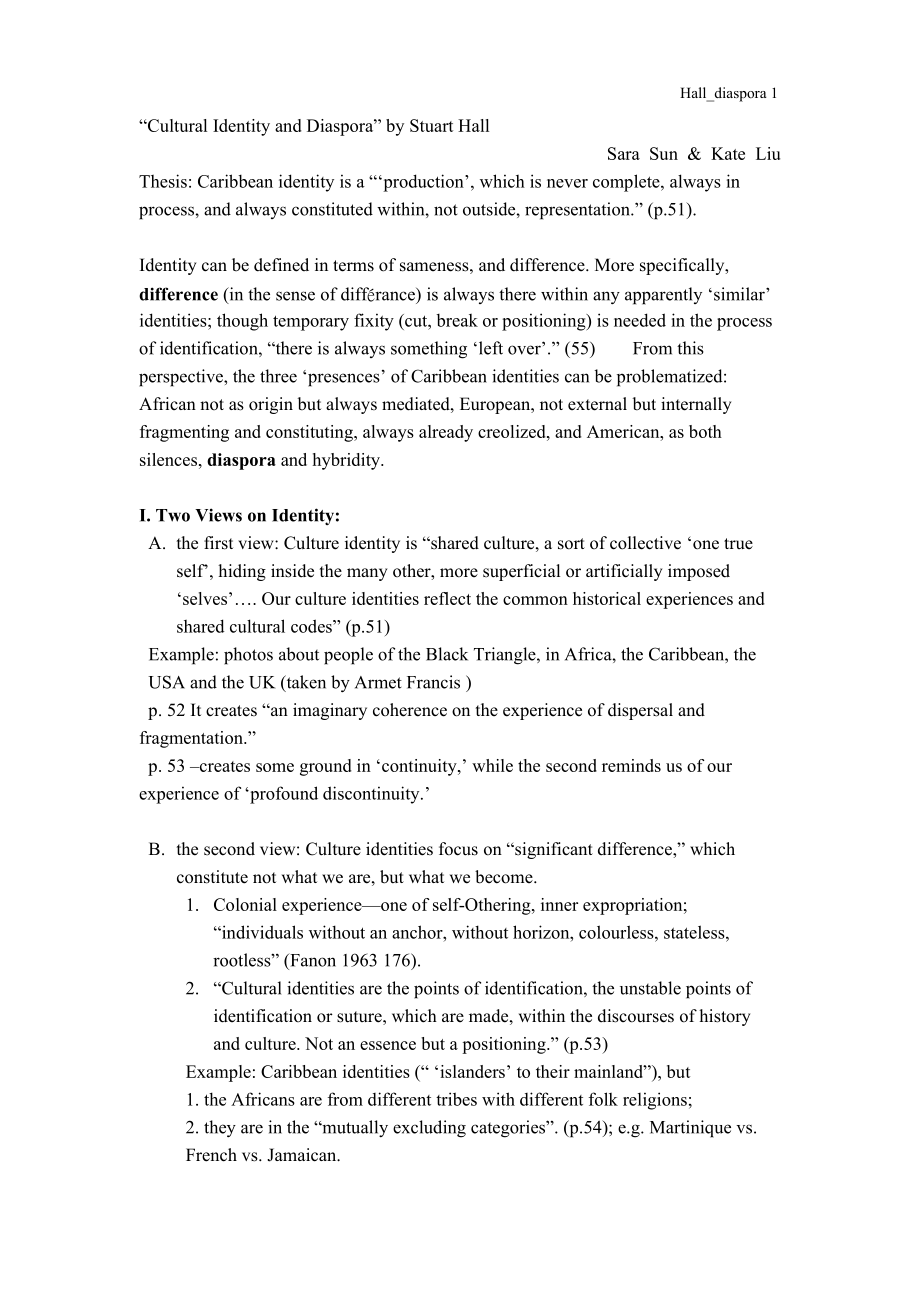 “Cultural Identity and Diaspora”Stuart Hall
“Cultural Identity and Diaspora”Stuart Hall


《“Cultural Identity and Diaspora”Stuart Hall》由会员分享,可在线阅读,更多相关《“Cultural Identity and Diaspora”Stuart Hall(2页珍藏版)》请在装配图网上搜索。
1、Hall_diaspora 2“Cultural Identity and Diaspora” by Stuart HallSara Sun & Kate LiuThesis: Caribbean identity is a “production, which is never complete, always in process, and always constituted within, not outside, representation.” (p.51).Identity can be defined in terms of sameness, and difference.
2、More specifically, difference (in the sense of diffrance) is always there within any apparently similar identities; though temporary fixity (cut, break or positioning) is needed in the process of identification, “there is always something left over.” (55) From this perspective, the three presences o
3、f Caribbean identities can be problematized: African not as origin but always mediated, European, not external but internally fragmenting and constituting, always already creolized, and American, as both silences, diaspora and hybridity. I. Two Views on Identity: A. the first view: Culture identity
4、is “shared culture, a sort of collective one true self, hiding inside the many other, more superficial or artificially imposed selves. Our culture identities reflect the common historical experiences and shared cultural codes” (p.51)Example: photos about people of the Black Triangle, in Africa, the
5、Caribbean, the USA and the UK (taken by Armet Francis )p. 52 It creates “an imaginary coherence on the experience of dispersal and fragmentation.” p. 53 creates some ground in continuity, while the second reminds us of our experience of profound discontinuity. B. the second view: Culture identities
6、focus on “significant difference,” which constitute not what we are, but what we become. 1. Colonial experienceone of self-Othering, inner expropriation; “individuals without an anchor, without horizon, colourless, stateless, rootless” (Fanon 1963 176). 2. “Cultural identities are the points of iden
7、tification, the unstable points of identification or suture, which are made, within the discourses of history and culture. Not an essence but a positioning.” (p.53)Example: Caribbean identities (“ islanders to their mainland”), but 1. the Africans are from different tribes with different folk religi
8、ons; 2. they are in the “mutually excluding categories”. (p.54); e.g. Martinique vs. French vs. Jamaican. II. Difference and diffrance1. “diffrance” (Jacques Derida): to “differ” and “defer” “Meaning is able to slide.” The determined meaning and fixed boundaries are challenged.2. Identity position i
9、s “strategic” and “arbitrary”.(54)3. There is always something left over. III. The three presences in the Caribbean Identities: 3. “Presenc Africaine”: “the site of the repressed” i) It suggests the “unspoken, unspeakable presence in Carribbean culture”. (p.55)ii) Always mediated. E.g. Reggae and th
10、e culture of Rastafarianism; iii) Not a home to go back to; “Africa” has been “ deferred as a spiritual, cultural and political metaphor”. (Said: “imaginative geography and history”) (p.56)4. “Presence Europeenne”:i) the “extrinsic” and external power of exclusion; ii) It is “a constitutive element
11、in identities”. It causes what Homi Bhabha called the “ambivalent identification of the racist world”. Identities are reconstructed and reformed.iii) Always creolized. 5. “Presence Americanine”: i) the “New-World” presence, “the beginning of diaspora, diversity, hybridity, and difference”ii) It is “
12、a juncture point”, where “the creolisations and assimilations and syncretisms were negotiated”. (57)* Diaspora: “the recognition of a necessary heterogeneity and diversity; by a conception of identity which lives with and through, not despite, difference; by hybridity”It contains an “overwhelming nostalgia for list origins”. (Lacans imaginary) (p.58)6. the dislocation of modern society (Ernesto Laclau)2. Identities are essential and contingent.
- 温馨提示:
1: 本站所有资源如无特殊说明,都需要本地电脑安装OFFICE2007和PDF阅读器。图纸软件为CAD,CAXA,PROE,UG,SolidWorks等.压缩文件请下载最新的WinRAR软件解压。
2: 本站的文档不包含任何第三方提供的附件图纸等,如果需要附件,请联系上传者。文件的所有权益归上传用户所有。
3.本站RAR压缩包中若带图纸,网页内容里面会有图纸预览,若没有图纸预览就没有图纸。
4. 未经权益所有人同意不得将文件中的内容挪作商业或盈利用途。
5. 装配图网仅提供信息存储空间,仅对用户上传内容的表现方式做保护处理,对用户上传分享的文档内容本身不做任何修改或编辑,并不能对任何下载内容负责。
6. 下载文件中如有侵权或不适当内容,请与我们联系,我们立即纠正。
7. 本站不保证下载资源的准确性、安全性和完整性, 同时也不承担用户因使用这些下载资源对自己和他人造成任何形式的伤害或损失。
